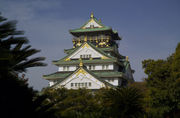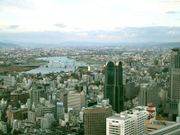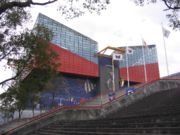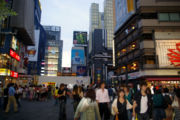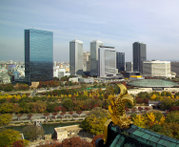Osaka
2007 Schools Wikipedia Selection. Related subjects: Geography of Asia
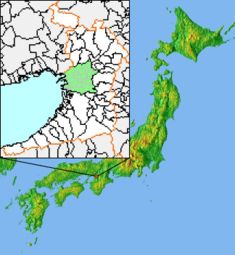 Osaka City's location in Osaka Prefecture, Japan. |
|
| Location | |
| Country | Japan |
| Region | Kansai |
| Prefecture | Osaka Prefecture |
| Physical characteristics | |
| Area | 222.11 km² |
| Population (as of February 2006) | |
| Total | 2,629,252 |
| Density | 11,838/ km² |
| Location | |
| Symbols | |
| Tree | Sakura |
| Flower | Pansy |
| Osaka City Hall | |
| Mayor | Junichi Seki |
| Address | 〒530-8201 Osaka-shi,Kita-ku Nakanoshima 1-3-20 |
| Phone number | 06-6208-8181 |
| Official website: Osaka City | |
Osaka (大阪市 Ōsaka-shi ?) listen is the capital of Osaka Prefecture and the third-largest city in Japan, with a population of 2.7 million. It is located in the Kansai region of the main island of Honshū, at the mouth of the Yodo River on Osaka Bay.
Osaka is the historical commercial capital of Japan and is still one of Japan's major industrial centers and ports, the heart of the Osaka-Kobe-Kyoto metropolitan area, which has a population of 18,644,000 . The city's daytime (9 a.m. – 5 p.m.) population is second in Japan after Tokyo.
History
The area which now consists of Osaka city was originally called Naniwa (難波, 浪華 or 浪花), a name which still exists as the names of districts in central Osaka as Naniwa (浪速) and Namba (難波). Emperor Kōtoku made this area his capital, and named it Naniwa-no-miya (the capital of Naniwa). It has always been a vital connection, by land and sea, between Yamato (modern day Nara Prefecture), Korea, and China. Settsu, a former province of Japan, consisted of the northern part of modern Osaka prefecture and the seaside part of Hyogo Prefecture.
Historical records seem to indicate that the Yamato people (the Japanese) first came upon the area, at the mouth of the Yodo River, in 663. They met resistance from the native people of the region, and fought them for roughly five years, before enthroning their emperor at a site called Kashiwabara. Naniwa was founded by Emperor Temmu in 683, in the location of what is now Osaka's Hōenzaka-chō District. In the seventh and eighth centuries, Naniwa served as the site of several Emperors' pleasure palaces. The city also served as one of the primary ports, providing economic and cultural contact with T'ang Dynasty China. Naniwa ceased to be the capital in 745, when the Imperial Court moved to Shigaraki no Miya and then to Heijo-kyō (now Nara). It remained a lively port for some time, but fell into decline by the 15th century.
In 1496, the Jodo Shinshu Buddhist sect set up their headquarters, the heavily fortified Ishiyama Hongan-ji temple on top of the ruins of the old Naniwa imperial palace. In 1570, Oda Nobunaga started a siege of the temple that went on to last for ten years. The monks finally surrendered in 1580, the temple was razed and Toyotomi Hideyoshi took the place for his own castle, Osaka Castle.
It is unclear when the name Ōsaka (written 大坂) gained prominence over Naniwa, but the oldest usage of the name dates back to 1496 in a text written about the foundation of the Ishiyama Hongan-ji. At this time, the pronunciation was Ōzaka. Over time, the "z" became voiceless.
In the beginning of Meiji Era, the government changed the second kanji 坂 to 阪 because of the previous one could, if the radicals were read separately, be interpreted as "(will) return to soil" (土に返る), which seemed a bit gloomy. This remains the official spelling today, though the old one is still in limited use.
Osaka was for a long time Japan's most important economic centre with a large percentage of the population belonging to the merchant class (see Four divisions of society). Over the course of the Edo period (1603-1867), Osaka grew into one of Japan's major cities, and returned to its ancient role as a lively and important port. Its popular culture was closely related to ukiyo-e depictions of life in Edo. Developing in parallel with the urban culture of Kyoto and Edo, Osaka likewise featured bunraku and grand kabuki productions, pleasure quarters, and a lively artistic community.
The modern city was designated on September 1, 1956 by government ordinance.
Attractions
Central Osaka is divided into two sections: Kita (北) ( north) and Minami (南) ( south). The retail district of Umeda (梅田) is located in Kita, while the entertainment area around Dotonbori Bridge with its famous giant mechanical crab, Triangle Park and Amerikamura ("America Village") is in Minami. Minami is also home to the Shinsaibashi (心斎橋) and Ebisubashi shopping districts. The central business district, including the courts and major banks, is primarily located in Yodoyabashi and Honmachi (本町), between Kita and Minami. Business districts have also formed around the city's secondary rail termini, such as Tennoji Station (天王寺駅) and Kyobashi Station (京橋駅).
Osaka is known for bunraku (traditional puppet theatre) and kabuki theatre, and for manzai, a more contemporary form of stand-up comedy. Tourist attractions include:
Amusement Parks
- Expoland
- Festival Gate
- Universal Studios Japan
Entertainment and Shopping Districts
- American Village (Ame-mura)
- Den Den Town electrical goods shopping district
- Dotonbori
- Doyama-cho Gay District
- Shin-Kabuki-za
- Shinsekai district and Tsutenkaku Tower
- Tobita red-light district
Historical Sites
- Osaka Castle
- Hiromitsu Ishida's Birthplace
- Shitennō-ji Temple
- Tobitashinchi
Museums and Galleries
- Farmhouse Museum in Hattori Ryokuchi Park
- Museum of Oriental Ceramics Founded in 1982. It houses 2000 pieces of ceramics, among them designated National Treasures. It also features a natural-light gallery for its Korean celadon pottery.
- National Museum of Art, Osaka
- National Museum Of Ethnology (Minpaku) with 12000 artifacts (250000 in store) on 9,000 square meters that stretch over 5 km.
- Osaka City Museum
- Osaka International Peace Centre (Peace Osaka)
- Osaka Municipal Oriental Porcelain Museum
- Osaka Municipal Science Museum
- Osaka Prefectural Museum of Kamigata Comedy and Performing Arts
Parks
- Nakanoshima Park
- Osaka Castle
- Sumiyoshi Park
- Tennoji Park
- Nishinari Park
Temples and Shrines
- Shitennō-ji Temple
- Sumiyoshi Taisha
Other
- Kaiyukan (海遊館) — an aquarium located in Osaka Bay, containing 35,000 aquatic animals in 14 tanks, the largest of which is the world's largest aquarium tank, holding 5,400 tons of water and housing a variety of sea animals including whale sharks.
- " Toilets of the World" exhibit in the International Finance Centre in Osaka Business Park (OBP), located just north of Osaka Castle park.
- Osaka Public Nakanoshima Library
- Osaka Central Public Hall
- Namba Grand Kagetsu
- Tennoji Zoo
- Asia Pacific Trade Centre
- Osaka WTC Building
- Osaka Dome
- Osaka-jo Hall
- Osaka Prefectural Gymnasium
Transport
Kansai International Airport is the main airport: it is a rectangular artificial island which sits off-shore in Osaka Bay and services Osaka and its surrounding satellite cities of Nara, Kobe, and Kyoto. Kansai is the geographical term for the area of western Honshū surrounding Osaka. The airport is linked by a bus and train service into the centre of the city and major suburbs.
Osaka International Airport in Itami and Toyonaka still houses most of the domestic service from the metropolitan region: its proximity to the Osaka, Kobe, and Kyoto city centers outweighs its noise restrictions.
Besides the Osaka Municipal Subway system there is a network of both JR and private lines connecting the suburbs of the city, and Osaka to its neighbours. Keihan and Hankyu line connect to Kyoto, Hanshin and Hankyu line connect to Kobe, the Kintetsu line connects to Nara and Nagoya, and the Nankai line to Wakayama.
Wards
Osaka has 24 wards (ku), one more than Tokyo:
|
|
Demographics
As of 2005, the city has an estimated population of 2,640,097 and the density of 11,894 persons per square kilometre. The total area is 221.30 km².
The people of Osaka speak a dialect of standard Japanese called Osaka-ben, characterised, most prominently amongst other particularities, by the use of the suffix hen instead of nai in the negative of verbs.
About 118,000 foreign residents are registered in the city. Its 91,500 Korean residents are mainly concentrated around Ikuno Ward, where a famous Korean town, Tsuruhashi, is located.
Economy
Historically, Osaka was the centre of Japanese commerce, especially in the middle and premodern ages. Today, many major companies have moved their main offices to Tokyo, especially from the end of 1990s, but several major companies are still based in Osaka. Below are some of the companies based in Osaka.
Major companies based in Osaka
|
|
Education
Public elementary and junior high schools in Osaka are operated by the Osaka City Board of Education , with public high schools being operated by the Osaka Prefectural Board of Education.
Osaka city once had a large number of universities, but because of growing campuses many universites chose to move outwards to different suburbs. Osaka is still a centre of higher education in Japan, comparable to Kyoto or Tokyo's 23 special wards. Osaka Prefecture's most prestigous university, Osaka University, is however located in the nearby Suita.
- Kansai University
- Osaka City University
- Osaka University of Economics
- Osaka Institute of Technology
- Osaka Jogakuin College
- Osaka Seikei University
- SOAI University
- Osaka University of Arts
Culture
Much can be said on the way the people of Osaka are perceived by people outside of Osaka, especially Tokyoites. The large bulk of these attributed features are in fact most of the time just exaggerated stereotypes, brought about by the portrayal of Osaka people by Tokyo television, and the almost extreme dominance of Osaka comedians in the manzai sphere. While the people of Osaka might embrace some of the stereotypes, and most feel a big divide between them and the Kanto Japanese, many will also be irritated how Tokyoites make fun of Osaka based only on what the Kanto produced TV programmes tell them about the city. A clear example of this was when Tokyo-based (but Shikoku-born) comedian Saibara Rieko made a remark on a variety show warning somebody going to Osaka that the tap water in Osaka prefecture is dirty and that they should make sure they didn't drink it. What was only a remark in passing became a big deal to the Osaka Waterworks which invited Saibara to Osaka to perform a blind test and see if she could distinguish local tap water from Tokyo tap water and mineral water. The blind test was televised, but to the disappointment of Osaka Waterworks, Saibara did recognize the Osaka water. Nevertheless, an apology was stated and Saibara said the Osaka water wasn't bad at all.
Some of the common features attributed to Osaka people are being good businesspeople, bustling with energy, happy and outgoing.
Osaka is also known for its food, as supported by the saying "Dress (in kimonos) till you drop in Kyoto, eat till you drop in Osaka" (京の着倒れ、大阪の食い倒れ). Osaka regional cuisine includes okonomiyaki (pan-fried batter cake), takoyaki ( octopus dumplings), udon (a noodle dish), as well as regional sushi and other traditional Japanese foods. It is said that to succeed in the Osaka food service business, the food must taste above-average, have larger servings than normal, be inexpensive and fast.
Being a big, business-based city, Osakans are thought of as always being in a rush. People consider a waiting period of more than 5 minutes too long in most cases. The typical Osakan will not wait for traffic signals to cross a street if there is no traffic.
Sister cities, Friendship and Cooperation cities, and Sister Ports
Osaka has eight sister cities and relationships of various sorts with several others .
Sister cities:
 Chicago, United States
Chicago, United States Hamburg, Germany
Hamburg, Germany San Francisco, United States
San Francisco, United States São Paulo, Brazil
São Paulo, Brazil Shanghai, People's Republic of China
Shanghai, People's Republic of China Melbourne, Australia
Melbourne, Australia Milan, Italy
Milan, Italy Saint Petersburg, Russia
Saint Petersburg, Russia Dubai, United Arab Emirates
Dubai, United Arab Emirates
Friendship and cooperation cities:
Osaka also has a number of sister ports, and several business partner cities.
